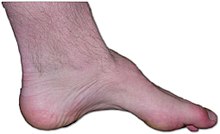User:Mr. Ibrahem/Charcot–Marie–Tooth disease
| Charcot-Marie-Tooth disease | |
|---|---|
| Other names | Charcot–Marie–Tooth neuropathy, peroneal muscular atrophy,[1] Dejerine-Sottas syndrome |
 | |
| The foot of a person with Charcot–Marie–Tooth disease with the characteristic lack of muscle, a high arch, and claw toes. | |
| Pronunciation | |
| Specialty | Neurology, orthopedics |
| Symptoms | Gradual onset of weakness starting in the legs, muscle loss[2] |
| Complications | Foot deformity, trouble walking[3] |
| Usual onset | 10 to 30 years old[2] |
| Duration | Lifelong[2] |
| Types | CMT1, CMT2, CMT3, CMT4, CMTX[2][1] |
| Causes | Genetic mutation[2] |
| Risk factors | Family history[2] |
| Diagnostic method | Nerve conduction study, genetic testing, nerve biopsy, nerve imaging[2] |
| Differential diagnosis | Spinal muscular atrophy with respiratory distress type 1 (SMARD1), muscular dystrophy, multiple sclerosis[2][4] |
| Treatment | Physical therapy, orthotic devices, exercise, surgery[2] |
| Prognosis | Progressive[2] |
| Frequency | 1 in 2,500[2] |
Charcot–Marie–Tooth disease (CMT) is a group of disorders that affects peripheral nerves.[3] Symptoms include gradual onset of muscle weakness starting in the legs and eventually involving the arms.[2] Both sides are affected and loss of muscle mass occurs.[2] Onset of symptoms is generally in a persons 10s or 20s.[2] About 25% of people experience pain and some develop numbness.[2][1]
It can occurs due to a number of different genetic mutations.[3] Most commonly it is due to issues with PMP22 on chromosome 17.[2] It can be autosomal dominant, X-linked, or autosomal recessive.[2] It is classified as a hereditary motor and sensory neuropathy.[2] Diagnosis may be supported by nerve conduction study, genetic testing, nerve biopsy, and nerve imaging.[2]
Treatment is supportive care which may include physical therapy, orthotic devices, and exercise programs.[2] Surgery may be done to improve foot, hip, or spine problems.[2] While the disease does not generally affect life expectancy, people do worsen with time and it can affect activities of daily living.[2]
Charcot–Marie–Tooth disease affecting about 1 in 2,500 people making it the most commonly inherited neuromuscular disorder.[2] Males are more commonly affected than females.[4] The condition was first described in 1886 by Jean-Martin Charcot, Pierre Marie, and Howard Henry Tooth.[2]
References[edit]
- ^ a b c "Charcot-Marie-Tooth Disease". NORD (National Organization for Rare Disorders). Retrieved 19 December 2020.
- ^ a b c d e f g h i j k l m n o p q r s t u v w x Nagappa, M; Sharma, S; Taly, AB (January 2020). "Charcot Marie Tooth". PMID 32965834.
{{cite journal}}: Cite journal requires|journal=(help) - ^ a b c "Charcot-Marie-Tooth disease | Genetic and Rare Diseases Information Center (GARD) – an NCATS Program". rarediseases.info.nih.gov. Retrieved 18 December 2020.
- ^ a b Ferri, Fred F. (2012). Ferri's Netter Patient Advisor E-Book. Elsevier Health Sciences. p. 647. ISBN 978-1-4557-2826-8.
